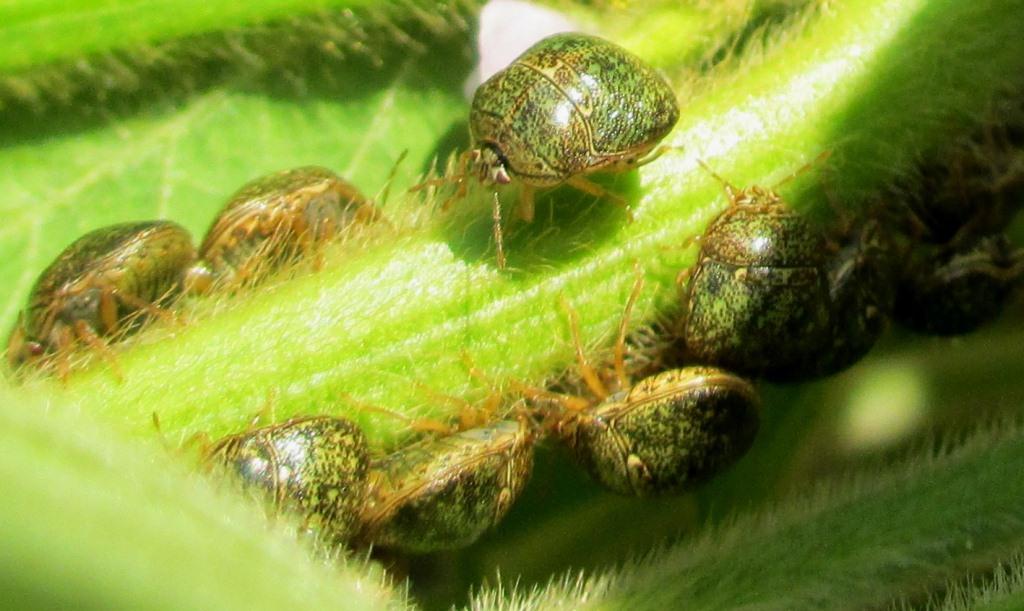
by Jennifer Bearden | Feb 24, 2015
![NISAW-logo09[1]](https://nwdistrict.ifas.ufl.edu/nat/files/2014/02/NISAW-logo091-300x119.jpg)
Kudzu Bug (Megacopta cribraria):
Florida is extending a warm welcome to a new pest! In 2012, the Kudzu bug made its first appearance in our state. And they are settling in to stay. The kudzu bug was first documented in the US in 2009 in Northeast Georgia. It has quickly spread throughout the southeast.
At first, a pest that attacks kudzu sounds pretty good but this bug also attacks wisteria, figs, and other legumes like beans and peas. It is a serious pest to soybeans that are grown in our area. They are similar to stink bugs and discharge an odor when disturbed. Skin and eye irritation can occur from this odor emission.
Kudzu bugs are small (3.5-6mm long), and are rounded oblong in shape, and olive-green in color. They lay egg masses in two rows of 13 to 137 eggs per row. The first generation of kudzu bugs seem to prefer to feed on kudzu but subsequent generations will feed on and lay eggs on other legumes. When fall comes, the adults over-winter where they can find shelter. They crawl under tree bark and into cracks in houses.

Kudzu Bugs feeding on soybean plants in Jackson County. Credit: Doug Mayo
If kudzu bugs make their way into your home, you can vacuum them up and dispose of them. If they are in your landscape or garden, you can set up a trap using a bucket of soapy water and a piece of white poster board. Kudzu bugs are attracted to lighter colors. To make the trap, cut the poster board in half. Attach the two halves by cutting a line up the middle of the two pieces and put them together. They should be in the shape of a plus sign. Place the board over the bucket of soapy water.
Insecticides can be used but timing and placement are very important. Right now, kudzu bugs are just becoming active making now a good time to spray kudzu host plants with an insecticide. Insecticide active ingredients ending in “-thrin” are effective against kudzu bugs. Controlling kudzu near your house will help decrease the number of bugs but they are strong flyers and can migrate through neighborhoods that aren’t near kudzu.
There are some natural enemies of kudzu bugs! Generalist predators like green lacewings, lady beetles, damsel bugs and big eye bugs will attack kudzu bug nymphs. There are also two parasitoids that attack them. A tiny wasp was discovered in 2013 that develops in the kudzu bug eggs. Also in 2013, a fly was discovered that lays its eggs in the adult kudzu bug.
For more information about kudzu bugs, refer to http://edis.ifas.ufl.edu/in939 or go to http://kudzubug.org
Beach Vitex (Vitex rotundifolia):
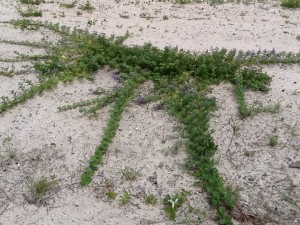
Beach vitex expands its woody rhizomes aggressively; it can actually grow over sidewalks and driveways.
Originally from the Pacific rim of Asia, Beach Vitex was brought to South Carolina to help restore dunes lost during storms. Also known as round-leaved chaste tree and pohinahina, this low-growing shrub does very well in coastal habitats. The plant is a small, deciduous shrub that can grow to a height of 3 feet and forms root and rhizome masses extending over 60 feet from the parent plant. The stems are fleshy when young but become woody with age. The leaves are simple and measure 1 – 2.5 inches in length, are ovate, and dark green on top while lower surface is light green to silver. Locally it flowers in the spring producing beautiful purple to light blue flowers. The fruit forms in mid-summer and are charcoal gray color.
Rapid growth and dense fruit production allows this plant to quickly dominate dune habitats, in some cases covering over 85% of the dune field and crowding out natives such as sea oats. The plant is also known to produce its own chemical weapons to help outcompete native species. Coverage is so thick in some areas the term “beach kudzu” is now being used. Conservation groups believe that this dense growth will negatively impact sea turtle nesting (both for egg laying adults and hatching young). In 2009 the plant was listed on North Carolina’s Noxious Weed List and there is now a statewide task force to combat this invasive. It was first reported in our area on Pensacola Beach. There are 22 known properties on Pensacola Beach and it could very well be found in other panhandle locations. Just recently, beach vitex was listed with UF/IFAS as “invasive not recommended.” If you suspect you have the plant you may contact your local Extension office for information on how to safely remove it. For more information visit www.beachvitex.org
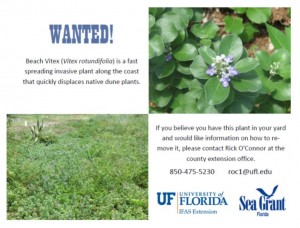
Click to download a “Wanted” Poster to share with neighbors and friends to lessen impact on our native species.
For more information, contact the author Rick O’Connor, UF/IFAS Extension Escambia County, Sea Grant/Marine Sciences Agent 850-475-5230.
by Jennifer Bearden | Feb 23, 2015
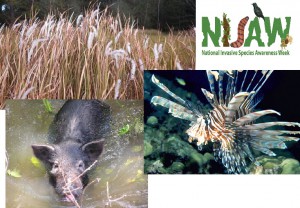 Many plants and animals have been introduced to new regions for centuries, as people have discovered new lands. These transient species are known as non-natives, and can become invasive. Invasive species occur throughout the world and may blend in, be nondescript or highly attractive; they can be plant or animal; terrestrial or aquatic; they may resemble or remind the viewer of something familiar; they may be very good at adapting to our climate and conditions which is how many invasive species get their foothold in an area. And because they have not evolved alongside our native species, when introduced to areas lacking their natural predators, they can adapt and take off.
Many plants and animals have been introduced to new regions for centuries, as people have discovered new lands. These transient species are known as non-natives, and can become invasive. Invasive species occur throughout the world and may blend in, be nondescript or highly attractive; they can be plant or animal; terrestrial or aquatic; they may resemble or remind the viewer of something familiar; they may be very good at adapting to our climate and conditions which is how many invasive species get their foothold in an area. And because they have not evolved alongside our native species, when introduced to areas lacking their natural predators, they can adapt and take off.
Conditions in the SE US are ripe for many invasive contenders. Some species have been intentionally introduced and other species have been accidentally introduced. Some common invasive species include red imported fire ants, Kudzu, Privet, Chinese tallow, Japanese climbing fern, Chinaberry, and cogongrass, just to name a few on the tip of the iceberg. These species are now out-of-control, and it is unlikely they will ever be eradicated from their new home.
In 2011 alone, the Department of the Interior spent more than $100 million on invasive species prevention, early detection and rapid response, control and management, research, outreach, international cooperation and habitat restoration in the US. (USFWS) This is a drop in the bucket when you consider in FY 1999-2000, nine Florida agencies spent $90.8 million on prevention, monitoring, control, and restoration efforts. It is estimated that the annual cost of invasive plants, animals and diseases in losses to Florida’s agriculture is estimated at $179 million annually (www.defenders.org).
Much like a cancer can spread in the body, so too, when conditions are favorable can invasive species spread across the landscape. Once established in the landscape eradication is expensive; ideally early monitoring is critical to understanding its movement and dispersal, coverage, and containment. Like cancers, early detection provides better opportunity to address the situation. Within the landscape, an aggressive invasive can impact the entire ecosystem – causing a serious imbalance; followed by a cascade of impact via unforeseen collateral damage.
Take the newest aquatic threat of Lionfish. The trophic impacts of lionfish could alter the structure of native reef fish communities and potentially hamper stock rebuilding efforts of the Snapper –Grouper Complex. Additional effects of the lionfish invasion are far-reaching and could increase coral reef ecosystem stress, threaten human health, and ultimately impact the marine aquarium industry. Control strategies for lionfish are needed to mitigate impacts.
Disturbances like new roads, land clearing, and tropical weather events (hurricanes) can all provide the opportunity for invasive species to get a foothold. So, the next time you notice a plant or animal that you don’t recognize, take a picture and report it using the “I’ve Got One!” phone app or on-line to The Early Detection & Distribution Mapping System (EDDMapS.org). You can also report to the nearest Extension Agent.
A good way to learn how to identify and control some of our common invasives is to join a volunteer workday at a park near you sponsored by the Six Rivers Cooperative Invasive Species Management Area (CISMA) or the Florida Native Plant Society.
GUEST AUTHOR: Barbara Albrecht, Director of Panhandle Watershed Alliance, member is the Six Rivers Cooperative Invasive Species Management Area.
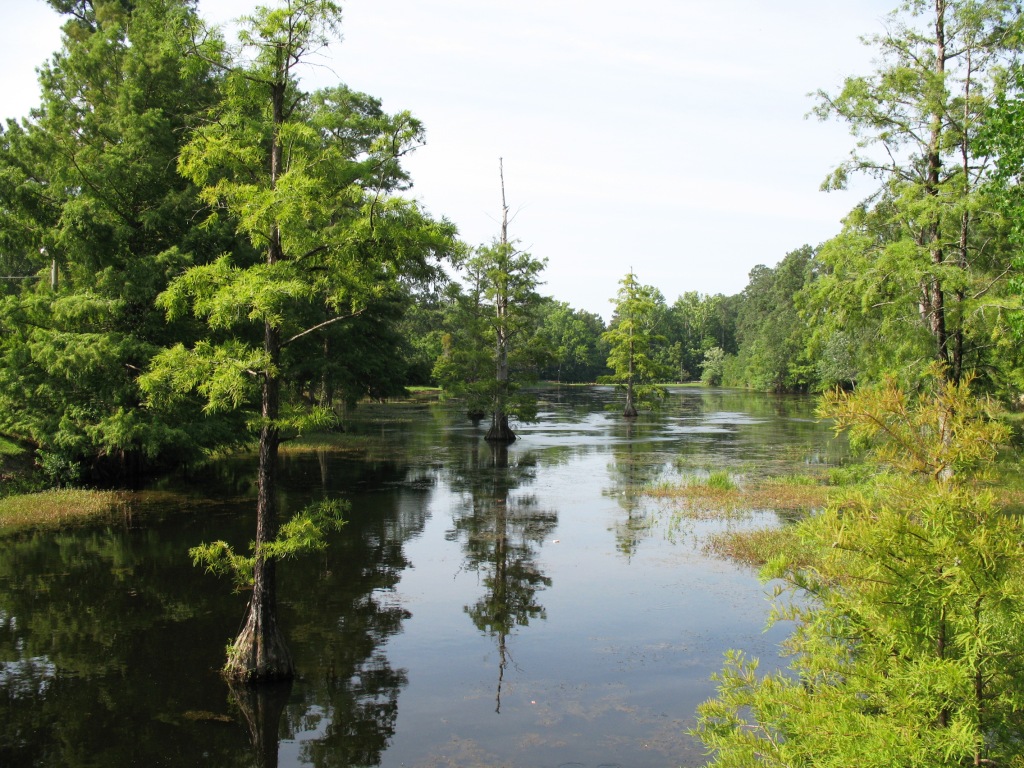
by Rick O'Connor | Feb 20, 2015
The Everglades Cooperative Invasive Species Management Area (ECISMA) is organizing a nonnative freshwater fishing tournament for Invasive Species Week.
Begins: 6:00 AM Saturday February 21, 2015
Ends: 12:00 AM Sunday March 1, 2015
OBJECTIVES FOR TOURNAMENT
- Document the distribution of freshwater nonnative fish in Florida
- Increase awareness of the problem with nonnative freshwater fish
- Encourage anglers to target nonnative species
RULES FOR TOURNAMENT
- All anglers must register on EDDMaps – this is easy… visit http://eddmaps.org/
- When recording on EDDMaps all data must complete with exact location (GPS preferred) and include a photo. Photos should have fish flat on a light colored background, in shade if possible, head facing left, and extend the fins as much as possible.
- The boundaries for the tournament are all legally fished freshwater bodies of water in Florida
- All fish must be caught within compliance with the State of Florida regulations. Visit MyFWC.com/fishing/freshwater/regulations or visit a local bait and tackle shop for these.
- Native species are not eligible
PRIZES FOR TOURNAMENT
Most Unusual Catch – Adult
- First Prize – $75 gift certificate to Bass Pro Shop and Lionfish Be the Predator T-shirt
- Second Prize – $50 gift certificate to Bass Pro Shop and Lionfish Be the Predator T-shirt
- Third Prize – $25 gift certificate to Bass Pro Shop and Lionfish Be the Predator T-shirt
Most Species – Adult
- First Prize – $75 gift certificate to Bass Pro Shop and Lionfish Be the Predator T-shirt
- Second Prize – $50 gift certificate to Bass Pro Shop and Lionfish Be the Predator T-shirt
- Third Prize – $25 gift certificate to Bass Pro Shop and Lionfish Be the Predator T-shirt
Most Unusual Catch – Youth
- First Prize – $50 gift certificate to Bass Pro Shop and Lionfish Be the Predator T-shirt
- Second Prize – $25 gift certificate to Bass Pro Shop and Lionfish Be the Predator T-shirt
- Third Prize – $15 gift certificate to Bass Pro Shop and Lionfish Be the Predator T-shirt
Most Species – Youth
- First Prize – $50 gift certificate to Bass Pro Shop and Lionfish Be the Predator T-shirt
- Second Prize – $25 gift certificate to Bass Pro Shop and Lionfish Be the Predator T-shirt
- Third Prize – $15 gift certificate to Bass Pro Shop and Lionfish Be the Predator T-shirt
For a list of nonnative targets you can visit EDDMaps.com, MyFWC.com, or contact your local county Extension office. We encourage all participants to take and eat what you catch.
DISCLAIMER
It is expressly understood that participants in the 2015 Nonnative Fish Catch, Click, and Submit enter at their own risk and that Everglades CISMA and all participating organizations, Officers, Event Sponsors, and Committees, and all other persons connected directly or indirectly with the operation of said event, shall be exempt from any liability for liable, slander, loss, damage, negligence, harm, injury, or death suffered by any participant, entrant, vessel, and equipment, companions, and guests, boat captains, mates, or crew members, which may occur in conjunction with the 2015 Nonnative Fish Catch, Click, and Submit.
For more information contact ECISMA at http://evergladescisma.org/.
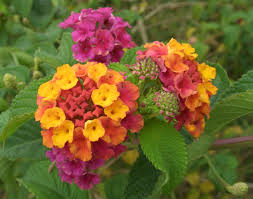
by Sheila Dunning | Feb 20, 2015
It’s Growing So Well It Must Be A Good Plant. Right?

Lantana camera
You know that plant in the corner of the yard that seems to be taking over? It’s the one that your friend “passed along” because they had plenty of them and wanted to share. After all, it grows so well. How can you go wrong? The odds are that vigorous plant is a non-native species. The majority of what is sold in nurseries are introduced from a foreign country and developed for their uniqueness.
The problem is that many of the plants brought into the United States arrive without their natural enemies. Under the long, warm growing season found in Florida, these non-native plants become the dominant plant in an area and manage to out-compete the native plants. When this happens, these introduced plants get labeled as an “invasive species”.
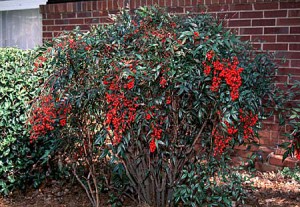
Nandina domestica
If you want to learn more about your friend’s ”passalong” plant be sure to visit the Assessment of Nonnative Plants in Florida’s Natural Areas website and database at http://assessment.ifas.ufl.edu/.
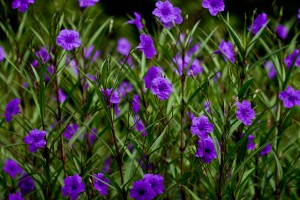
Ruellia brittoniana Mexican Petunia
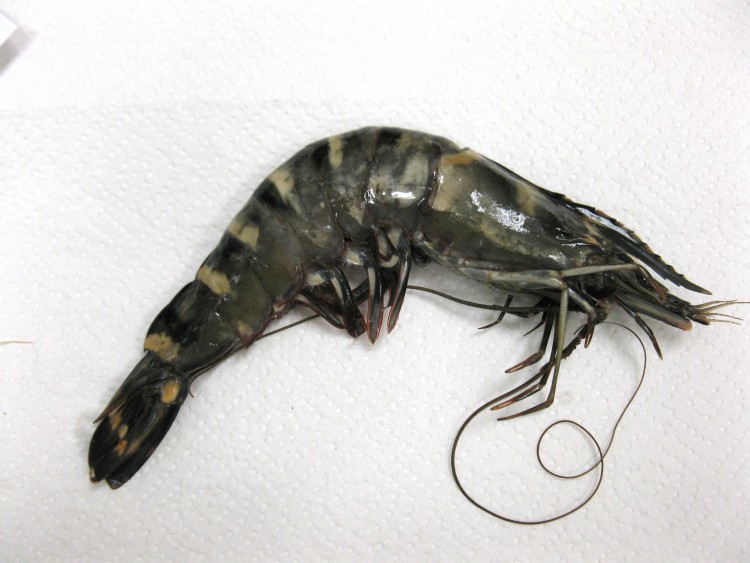
by Rick O'Connor | Nov 7, 2014
This catchy phrase coined by Robert Turpin (Escambia County Marine Resources Division) describes the new invader to our marine waters. Many coastal residents are aware of the invasive lionfish that has invaded our local reefs but few have probably heard of the Asian Tiger Shrimp. This member of the penaid shrimp family, the same family are edible white, brown, and pink shrimp come from, was brought to the United States in the 1960’s and 70’s as an aquaculture project. Over the years farmers have moved from Tiger Shrimp to the Pacific White Shrimp and the last known active farm was in 2004.
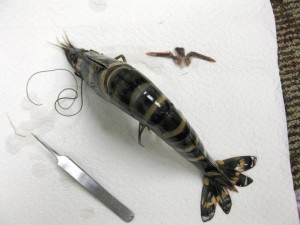
The Asian Tiger Shrimp can reach lengths of 12″
In 1988 2000 of these shrimp were lost from a farm in South Carolina during a flood event. 10% of those were recaptured and some were collected as far away as Cape Canaveral. No more was heard from this release until 2006 when 6 were captured; one of those in Mississippi Sound near Dauphin Island. Each year since the number of reported captures has increased suggesting they are breeding.
2006 – 6 captured
2007 – 4 captured
2008 – 21 captured
2009 – 47 captured
2010 – 32 captured
2011 – 591 captured
One individual was caught in 2011 near Panama City and 5 were collected in 2012 in Pensacola Bay. In recent weeks the Sea Grant Agent in Escambia County has received reports of numerous Tiger Shrimp being collected from Escambia Bay. There is currently no scientific evidence of negative impacts of this shrimp in our area. They are aggressive predators of benthic invertebrates and may out compete our native penaid shrimps and could possibly feed directly on the juveniles.
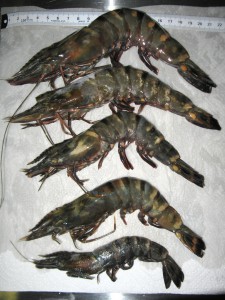
Five tiger shrimp captured by shrimpers in Pensacola Bay.
NOAA scientists are interested in obtaining samples of this shrimp for DNA studies. It differs from other local penaid shrimp in that it is larger (8-12” long), dark in color (dark green to black) and has light stripes (white to cream colored). The larva and juveniles live in the bay. Sub adults will migrate offshore for breeding. They are a tropical species that have a low tolerance for cold temperatures, showing no growth below 20°C, but have a high tolerance for changes in salinity. If you thing you may have one of these shrimp and are interested in donating one, please contact Sea Grant Agent Rick O’Connor at (850) 475-5230 or roc1@ufl.edu.
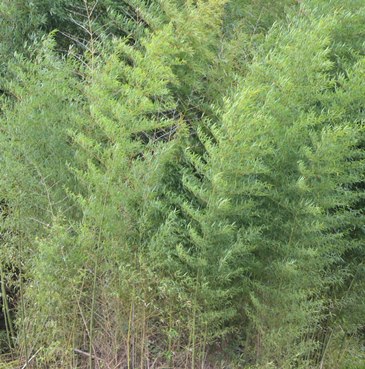
by Les Harrison | Oct 26, 2014

Golden bamboo quickly establishes in an areas and pushes out all other plants.
Bamboo, the tallest grass in north Florida, can be an attractive landscape specimen or an invasive nightmare. There are more than 700 species of bamboo worldwide, ranging in height from 12 inches to 100 feet or more in ideal growing conditions.
In the U.S., only two species occur naturally (Arundinaria gigantea and A. tecta). Neither of these two plants are used for human food, but other bamboos are a dietary staple or flavoring condiments in Asia and Africa.
Bamboo holds two impressive records in the plant kingdom. It is the largest perennial grass on the planet and it can be the fasted growing plant under the perfect environment.
It has been deliberately propagated and used as an ornamental plant for many years in Florida. The wide variety of colors and textures combined with the exotic shaped and delicate leaves add to the landscaping appeal.
Generally speaking, the two native bamboos are not extremely weedy and are relatively easy to manage. However, there are scores of imported bamboos which are highly invasive and exceedingly difficult to contain in a limited area.
The most common invasive bamboo (Phyllostachys aurea) is commonly known as fishing pole or golden bamboo. It was imported into this country in the 1880’s as an ornamental, being popular as a cold-hearty and quick growing privacy screen.
Because of its weight and relative strength it became an inexpensive and popular source of fishing poles. Curiously, expensive bamboo fly fishing rods are usually made from a less common, but stronger bamboo species native to China.
This and other invasive bamboo varieties have large and complex underground root systems called rhizomes. These shallow roots maintain the plant’s viability by storing and distributing large volumes of nutrients.
Once an invasive bamboo is established the root system supports rapid growth and expansion. Other plants are quickly overwhelms and pushed out.
To control these invasive varieties, the entire rhizome network must be killed. This makes control of bamboo expensive, intensive, time consuming and difficult.
Being a grass bamboo easily tolerates occasional pruning, but regular and intensive mowing is much more effective for destroying this plant. The mowing frequency is similar to a home lawn if success is to be achieved.
The removal of the plant’s above-ground portion is required to deplete the rhizomes and exhaust it. One to two seasons of rigorous mowing is needed before control is achieved.
To learn more about invasive bamboo, contact your local UF/IFAS Extension Office or read IFAS Publication WG 209: Integrated Management of Nonnative Plants in Natural Areas of Florida at http://edis.ifas.ufl.edu/wg209.




![NISAW-logo09[1]](https://nwdistrict.ifas.ufl.edu/nat/files/2014/02/NISAW-logo091-300x119.jpg)









